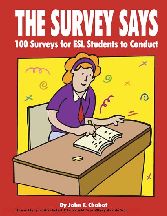Suchen und Finden
Introduction ,(p. v)
The Survey Says includes 100 surveys for your ESL students to conduct. Each survey includes 10 questions. The surveys may be used with high-beginner to advanced learners of English. As a language teacher you are always looking for interesting and engaging activities with which to teach your students. The same is true for the ESL conversation class. For the ESL conversation class, you are looking for ways to involve your students in meaningful opportunities to speak and interact in their second language.
Surveys are one such activity. What is a survey? A survey is a list of pre-determined questions used to gather information. Surveys can be used to gather information about beliefs, values, attitudes, opinions, experiences and needs. The surveys in this book will work perfectly as an in-class assignment with your students polling each other. The surveys in this book will also work perfectly as an exercise to be done outside the four walls of a classroom with your students asking native English speakers to respond. In fact, it is probably best to have your students poll each other in class as practice before sending them out to poll people outside the class.
Minimum before sending out your ESL pollsters you should go over the questions to be sure everyone has a clear understanding of the survey and questions they will be asking others. The surveys included in this book are all closed questions, which means respondents must choose from a list of possible answers, rather than open-ended questions which require the respondents to give their own unique answers to the questions being presented.
Closed questions make the survey process more manageable and less intimidating for ESL students. The data your students collect can be analyzed and statistics can be generated. From these statistics, conclusions (generalities) may be drawn. The surveys do not ask respondents to indicate their age or gender or any other such personal information. You can instruct your students to collect such information, if you determine it to be relevant. Such personal information may make the survey more interesting because differences and similarities between people of a certain age or gender may become obvious.
You may choose to tell your students to ask only a certain type of person (e.g. only ask women). Or you may choose to designate certain students to ask certain types of people (e.g. some students only ask women, some students only ask men). It is entirely up to you how the survey is run. It is up to you to decide how many people you want each student to poll. If you choose to have each of your students ask more than one person to answer the survey, it is recommended that you either give your students multiple copies of the questionnaire or you have then write their answers on a separate piece of paper.
Alle Preise verstehen sich inklusive der gesetzlichen MwSt.








